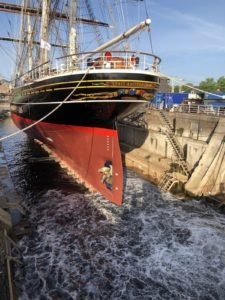Britain’s greatest maritime tragedy – 80-year anniversary

Yesterday marked the day that Britain suffered the greatest naval tragedy in its history.
On the afternoon of June 17, 1940, His Majesty’s Troopship Lancastria was attacked by German bombers off St Nazaire. All day her decks had been filled with British troops, fleeing Hitler’s armies as the panzer overran southern France.
Following the Dunkirk evacuation, the Germans ran rampant across France and the Royal Navy was forced to improvise evacuations from French ports: Cherbourg, St Malo, and Brest.
By June 17, St Nazaire was the focal point of those efforts. The Loire estuary throbbed with boats, ferrying men out to the ships at anchor in the St Nazaire roadstead, among them veteran liner Lancastria.
Built to carry 2,200 passengers, her captain was willing to allow 3,000 troops aboard. At the last count before he stopped any more embarking, the First Officer reckoned 5,000 soldiers had boarded. Some accounts place the figure as high as 6,000.
Around 2pm, the first Luftwaffe bombers appeared, attacking – and damaging – a second troopship, Oronsay. Rather than take it as a cue to set sail, Lancastria’s skipper decided to wait until Oronsay was repaired and a strong destroyer escort was available.
The delay proved fatal. A second wave of Junkers 88 dive-bombers soon appeared. This time they concentrated on the Lancastria, hurling 250 and 500kg bombs at the liner as sirens on their undercarriage howled.
Lancastria was hit – she “bucked and shuddered like an animal in pain” according to her First Officer Harry Grattidge. One bomb landed in a hold containing around 800 RAF personnel, another exploded in a second hold, causing fuel to spill out, and one perhaps plunged down the funnel.
The troopship went down in less than 20 minutes, turning over as she went.

Those who could jumped into the oily water – there was little chance to launch the lifeboats – grabbing on to wreckage in a bid to stay afloat. They sang to maintain morale – and remain conscious – as they awaited rescue by destroyer HMS Highlander or trawler HMT Cambridgeshire: There’ll always be an England, Roll out the Barrel and, more fittingly, Abide With Me.
Some 2,477 people were rescued from the Lancastria, mostly troops, but also British and French civilians, even babies. At least that number died, more likely 3,500, although some suggest the toll was more than 5,000.
The evacuation of British and Allied troops brought back 191,870 Servicemen, 144,000 of them Britons. In all, the concerted efforts to evacuate the British Expeditionary Force in May and June 1940 saved 558,000 fighting men, two in every three of them British.
News of the Lancastria was hushed up by Churchill. “The newspapers have got quite enough disaster for today,” he determined. It was late July before British newspapers learned of the disaster – via American newspapers. By then, Britain was involved in the fight for her very existence and the loss of the liner was quickly forgotten about. It took nearly 50 years for the first official memorial to be erected, a huge piece of granite, engraved in gold, mounted on a stone plinth on the St Nazaire seafront overlooking the liner’s last resting place, bearing a simple inscription: We have not forgotten.










